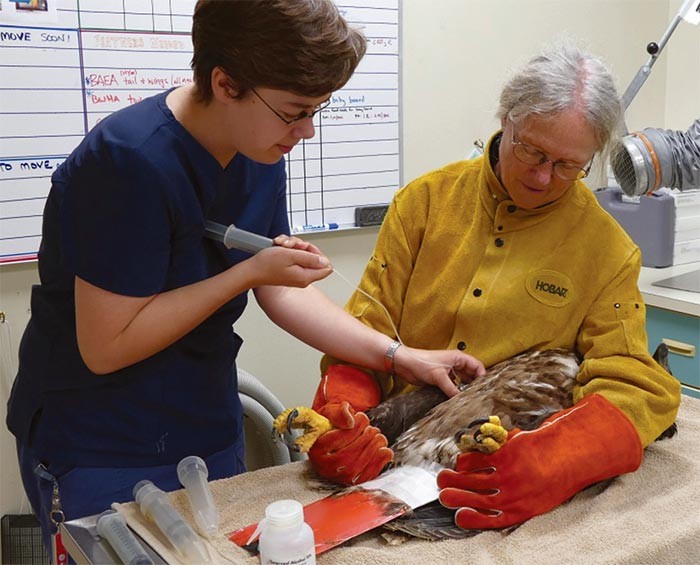November 15, 1976. Late that morning I would shoot my first deer, a buck. But what I remember most about that day is a bird. Burned into my mind is the image of a northern goshawk tail-chasing a ruffed grouse through branches in the young forest.
Perhaps that’s not so strange. I’ve talked to hundreds of hunters about this and they almost universally love to watch wildlife while they’re out in the woods. Another thing I learned from talking to hunters: very few are aware of how lead bullets inadvertently poison and kill some of the wild animals they love.
At the root of this problem is bullet fragmentation. Lead is cheap and easy to work; it’s unusual in that it is both soft and fragile. It’s so fragile, in fact, that the speeds achieved by modern rifles made pure lead bullets obsolete. But even modern copper-jacketed lead rifle bullets still fragment on contact, sometimes into hundreds of pieces. These fragments are highly toxic, and they travel: In mortality simulation studies, lead contamination has been found as far as 18 inches from the wound channel.
This is not just a problem for the human hunters who will eat the deer meat. The large raptors we see in the Northeast are hunters themselves, but they are also seasonal scavengers. In New York, 200,000 deer are harvested by hunters each fall. About 90 percent of these are shot with lead-core bullets, and much of this lead remains in the gut pile that’s left out in the woods. Add to this the deer that are wounded but not recovered and there’s a lot of toxic lead being left out for scavengers to consume.
The Raptor Center at the University of Minnesota received more than 2,000 bald eagles for rehabilitation from 1974-2009. According to veterinarian Julia Ponder, executive director of The Raptor Center, more than 90 percent of the eagles the group received (including 183 in 2016) had measurable lead levels. Of these, 25-30 percent had lead toxicity high enough to cause clinical lead poisoning (20 μg/dL or 0.2 ppm). “These patterns of lead exposure have been consistent for decades,” said Ponder. “The majority of birds with clinical lead poisoning die.”
While awareness of the problem is growing, mortality rates in some places are, too. From 2000-2004, the New York State Department of Environmental Conservation (NYSDEC) Wildlife Pathology Lab received on average one dead lead-poisoned bald eagle each year. From 2011 2015, the average had risen to 4.6. And most dead eagles are never found. In eagles, classic symptoms of lead poisoning include not moving, not feeding, drooping wings, and a dirty tail. During the winter of 2016, a bald eagle being GPS-tracked by NYSDEC spent weeks feeding at a spot in the Catskill Mountains. Then, it stopped moving. A biologist found the bird alive, but severely lead-poisoned. It had been feeding on a commercial deer processor’s pile of butchering waste. Another dead eagle was found nearby. The GPS-tracked bird was treated and released. It appeared healthy, being able to remove fish from a kiddie pool while being rehabilitated. Unfortunately, it starved three weeks later, likely having suffered irreparable brain damage.
This is not just a problem in New York. Research shows that it is a problem throughout the eastern US during the late fall and winter months, which is also during and directly after hunting seasons. From 2010 to 2016, a number of wild bald and golden eagles were captured in the eastern U.S. by scientists and rehabilitators. Blood was drawn from these birds immediately and later tested for the presence of lead. Consistent with other studies, lead levels varied seasonally. According to Vince Slabe, graduate research assistant at West Virginia University, 28 percent of the 81 eagles captured during those years between Nov. 1 and March 31 were found to have blood lead levels of 20 μg/dL or higher. Of the 24 eagles captured during the period ranging from April 1 to October 31, all were below 8 μg/dL.
Poisoned wildlife is just one reason for hunters to switch to non-lead bullets. Lead also poses a human health risk, especially to children. Typically, higher amounts of lead are found in commercially processed meat. Hunters processing their own may take more care. Even so, some states recommend that small children and pregnant women avoid eating wild game killed with lead.
Increasingly, bullet manufacturers are offering alternatives to lead ammunition, with highly accurate, non-lead bullets now available (and prices are going down) for any caliber of rifle. Besides keeping lead out of the environment, non-lead bullet performance is generally superior and many hunters switch just for better performance. If you hunt, consider the benefits of choosing non-lead bullets this season.






